| |
1. Environment-sensitive lifetime dyes |
|
| |
Selected Square and Seta dyes exhibit shorter fluorescence lifetimes (FLTs) in aqueous media or when labeled to low molecular weight analytes (drugs or small ligands) but increased brightness and up to ten-times longer FLTs when bound to proteins or oligonucleotides. These environment-sensitive Seta and Square labels are well-suited as tracers in FLT-based assays, where, e.g., the FLT-tracer would be labeled to a small antigen (ligand) displaying a short lifetime but showing a substantial FLT-increase upon binding to a larger protein (antibody or receptor). K8-1300 is also used as a fluorescent probe that binds to hydrophobic regions in cells.
The table below provides data on the expected changes in lifetime for selected FLT dyes. It is important to note that the observed lifetime change of a fluorescently labeled ligand will strongly depend on the nature and size of the biomolecule it binds to:
|
| Product |
Dye |
Dye–Conjugate |
Δτ[ns]
τ(Dye–conj.) – τ (Dye) |
| τmean [ns] |
D/P ratio |
τmean [ns] |
|
|
0.46
|
0.96
|
3.2
|
2.80
|
|
|
0.29
|
1.2
|
3.3
|
3.09
|
|
|
0.3
|
1.0
|
3.0
|
2.70
|
|
|
0.25
|
1.0
|
2.8
|
2.56
|
|
| |
SETA BioMedicals offers several environment-sensitive FLT labels excitable with the 633, 635, 647 nm laser sources, including He-Ne, Kr-ion, Ti-Sapphire, and DPSS lasers.
|
|
|
a) FLT probes
Probes such as Square-670 (K8-1300) show large changes in FLT upon binding to either proteins or cell surfaces. K8-1300 is water-soluble but with a strong affinity for the hydrophobic regions of biomolecules. |
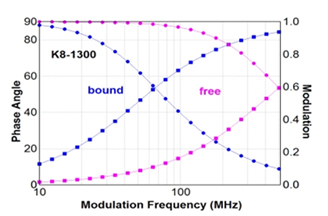 |
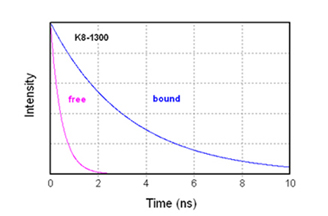 |
Comparison of the frequency responses of Square-670 (K8-1300)
before and after binding to protein
(τfree = 460 ps; τbound = 3.26 ns) |
Comparison of the intensity decays of Square-670 (K8-1300)
before and after binding to protein
(τfree = 460 ps; τbound = 3.26 ns) |
|
| |
Square 650-pH is a NIR probe that exhibits a pKa around 7 and is therefore useful for measurement of pH changes in the physiologically relevant pH range from pH 6 to pH 8. Importantly, both forms (protonated as well as unprotonated) of Square 650-pH are fluorescent, and they exhibit different lifetimes, which makes this compound useful for lifetime-based applications (see Figure below). For more information about these dyes, we refer you to their spec sheets and the published literature.
|
|
|
|
| |
| b) Hydrophilic FLT labels |
| These are reactive labels that show changes in FLT upon binding to either proteins, oligonucleotides, or cell surfaces. In general, they are labeled to a low-molecular-weight binding partner, and interaction with a high-molecular-weight protein or receptor leads to a change in FLT: |
| |
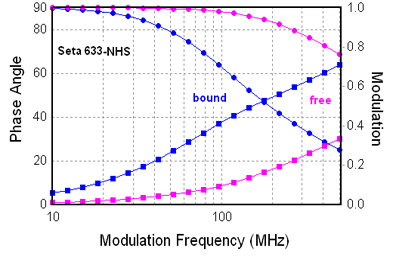 |
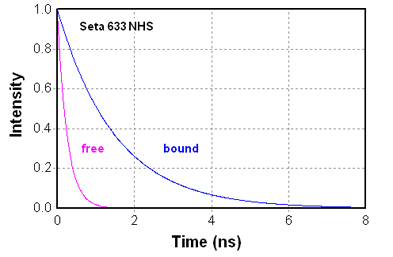 |
Comparison of the frequency responses of Seta-633 (K8-1663)
before and after binding to protein or oligos.
(τfree = 250 ps; τbound = 2.8 ns) |
Comparison of the intensity decays of Seta-633 (K8-1663)
before and after binding to protein or oligos.
(τfree = 250 ps; τbound = 2.8 ns) |
|
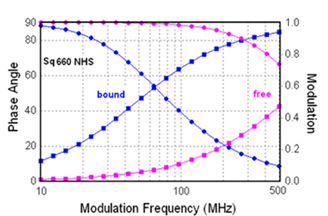 |
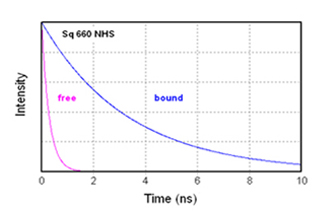 |
Comparison of the frequency responses of Seta-660 (K8-1352)
before and after binding to protein or oligos.
(τfree = 290 ps; τbound = 3.3ns) |
Comparison of the intensity decays of Seta-660 (K8-1352)
before and after binding to protein or oligos.
(τfree = 290 ps; τbound = 3.3 ns) |
|
| |
2. Environment-insensitive lifetime labels
a) Long-lifetime, short-wavelength FLT labels
These proprietary long lifetime labels with lifetimes in the range between 32 and 9 ns are excitable in the UV or blue region. They are useful as polarization probes for the measurement of high MW analytes (small - medium size proteins).
SeTau-425-NHS (K7-545), for example, was used to measure BSA with a molecular weight of 65 kDa in an FP assay. Importantly, the FLT of these labels does not change upon labeling or binding to proteins or analytes. |
| |
| Product |
Lifetime [ns] |
| SeTau-380-NHS (K1-204) |
32 |
| SeTau-404-NHS (K7-549) |
9 |
| SeTau-405-NHS (K7-547) |
9 |
| SeTau-425-NHS (K7-545) |
26 |
|
| |
| |
|
b) Long-wavelength, squaraine-rotaxane-based FLT labels
These reactive labels are excitable in the red and NIR region and are useful as polarization probes for the measurement of low-MW analytes. SeTau-655-NHS, SeTau-647-NHS, or SeTau-665-NHS are examples of FLT labels with lifetimes that are insensitive to the environment. The average lifetime of these labels is in the order of 2.5 – 4 ns, which makes them superior lifetime or polarization probes over Cy5 or Alexa dyes (Cy5, Alexa 647: lifetime ~ 1 ns in water). The longer lifetimes make them also more suitable donors in energy-transfer-based assays, assuring that even at higher energy transfer rates, the lifetime of these labels is not too short to be accurately measured with inexpensive instrumentation.
|
| Product |
Lifetime [ns] |
|
SeTau-647-NHS
|
3.2 |
|
SeTau-665-NHS
|
3.1 |
|
| |
| |
|
| |
|